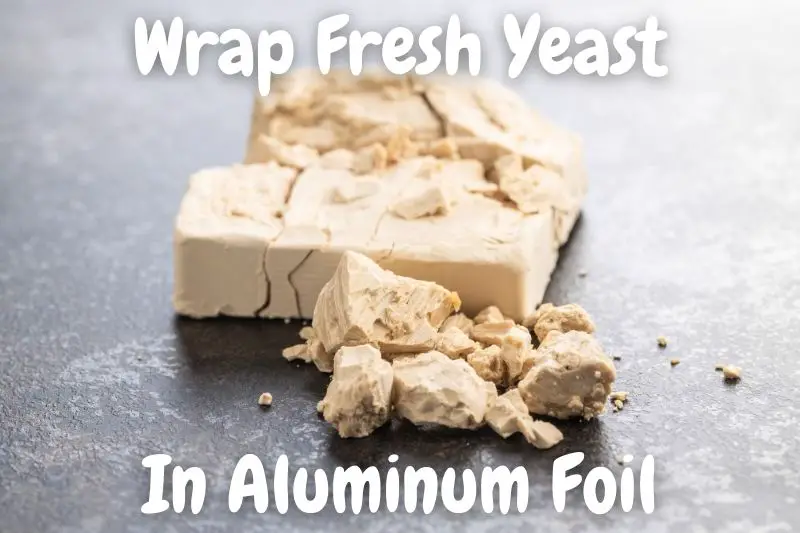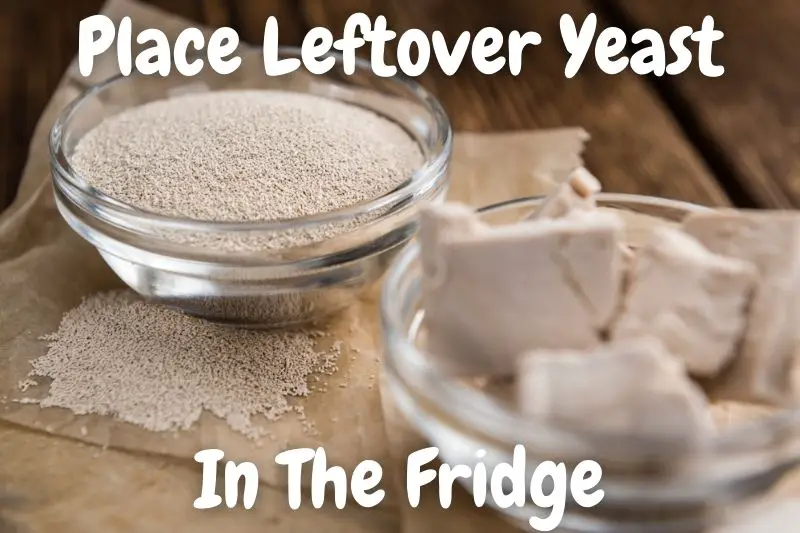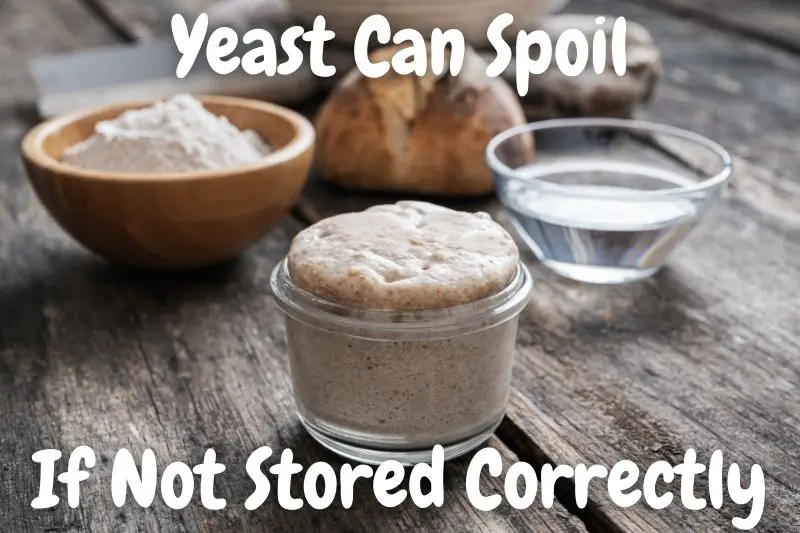This post contains affiliate links.
Yeast is an important component of many baking recipes. There are several different types of yeast that you should be familiar with, especially if you’re interested in baking bread or other types of food that require a leavening agent.
As a general rule, yeast requires refrigeration for storage. Store the yeast in an air-tight container and place it in the fridge. This goes for both active dry yeast and instant yeast. Because fresh yeast is light sensitive, divide the yeast and wrap it in aluminum foil to prevent spoilage.
Keep reading to learn more about each type of yeast as well as how to store and preserve them for optimal freshness!
How To Properly Store Active Dry Yeast After Opening?
Generally speaking, once active dry yeast is opened, it should be stored in the refrigerator. Active dry yeast will keep fresh in the fridge for up to four months if it has been stored correctly. Storing in an air-tight container helps prevent any moisture from seeping in and spoiling the yeast.
Here is a table that illustrates the approximate shelf life of yeast once opened:
| Type of Yeast | Room Temperature | Refrigerator | Freezer |
|---|---|---|---|
| Instant Yeast | Up to 2 months | Up to 4 months | Up to 6 months |
| Active Dry Yeast | Up to 3 months | Up to 4 months | Up to 6 months |
| Fresh Yeast | Up to 2 weeks | 3-4 weeks | Up to 3 months |
If you’re looking for a good set of airtight storage containers, I recommend getting the Rubbermaid Brilliance Leak-Proof Food Storage Containers with Airtight Lids.
I’ve used these containers for a couple of years now and I’ve successfully stored all of my food and baked goods in room temperature, fridge, and freezer. I’ve even used them in the microwave! These containers come in many different sets, so choose the right one for you. You can check out these containers on Amazon!
Active dry yeast should always be stored somewhere cool and protected from any moisture. A cupboard or pantry is a good spot, however, once it’s been opened you’ll have to take additional measures to prevent it from spoiling.
Once you’ve opened up active dry yeast, your best bet is to store it in a food-safe container with a well-fitted lid. This will protect it from outside elements. Store it in the fridge and it will keep for up to four months.
If you’d like to extend your active dry yeast’s shelf life you can also place it in the freezer.
Store it in the freezer by taking the same precautions as if you were storing it in the refrigerator and your yeast will stay fresh for up to six months.
How To Properly Store Instant Yeast After Opening?
As a general rule, instant yeast must be stored in the refrigerator or in the freezer in order to keep fresh. It should also be stored inside an airtight container to avoid spoiling. This prevents the yeast from being exposed to any moisture which accelerates spoilage.
If you’re using instant yeast your storage prep and shelf life will be quite similar to active dry yeast. Although your instant yeast will last for about two years if it remains sealed, once it’s opened you’ll have to take precautions against spoilage.
When it comes to staying fresh, exposure to air is your instant yeast’s enemy.
Exposure can dramatically shorten its lifespan, so make sure you store it in an airtight container. A glass mason jar with a tight-fitting lid can be a good storage solution for your instant yeast and will keep it fresh for up to four months in the fridge and six months if placed in the freezer.
*Side Note: I recently wrote an article that breaks down Can You Use Bread Flour To Bake Cookies. This article talks about what you should expect when Baking Cookies With Bread Flour. You can check out this article here!
How To Properly Store Fresh Yeast After Opening?
As a whole, fresh yeast is sensitive to light so it must be divided up and stored in individual pieces wrapped in aluminum foil. It can be stored in the refrigerator for up to three weeks or in the freezer for up to three months. It is crucial to wrap in foil to prevent degradation from light.
Many professional bakers prefer using fresh yeast due to the rich, slightly sweet quality it adds to baked goods. The major drawback with using fresh yeast is its much shorter shelf life when compared to active dried and instant yeast.
Under the best conditions, fresh yeast will keep for about two weeks before it starts to spoil.

If you’re baking with fresh yeast for a special occasion and plan on storing it away, make sure you first wrap your fresh yeast in either cling wrap or parchment paper. Protecting your fresh yeast from exposure to air and storing it in the fridge will keep it fresh for up to two weeks.
There is some debate as to whether you can store your fresh yeast in the freezer.
While some people may successfully store their fresh yeast in the freezer for up to three months, it’s important to keep in mind that fresh yeast can be finicky when it comes to extreme temperatures.
If you’re attempting to store your fresh yeast in the freezer, make sure you completely wrap and seal your yeast in cling wrap and parchment paper to protect it from the elements.
To do this, I recommend getting an Impulse Poly Bag Heat Sealer which is used to melt one layer of plastic into another, creating a strong permanent seal that can only be broken by cutting or ripping it open. You can check it out on Amazon!
It’s crucial to make sure there are no exposed areas on your fresh yeast to avoid freezer burn and spoilage.
How Long Does Each Type Of Yeast Last If Not Stored?
Generally speaking, active dry yeast will expire within four months if not stored properly. Instant yeast will go bad within two to four months. Fresh yeast will go bad within four weeks if it is not stored properly. Store yeast in a container and keep it in the fridge for optimal use.
Opened and exposed active dry yeast and instant yeast have a similar shelf life when they aren’t stored correctly.
Active dry and instant yeast might keep for up to four weeks if they aren’t stored in the refrigerator or freezer, however, you always want to store your opened yeast in order to keep it fresh and prevent spoilage.
Fresh yeast will start to spoil within six hours if it’s left out at room temperature, so be sure to store it in the refrigerator once you’re done using it!
The bottom line is regardless of the type of yeast you’re using, always store it away safely to prevent spoilage or food-borne illnesses.
Do You Need To Refrigerate Yeast?
As a general rule, to prevent the spoilage of yeast, it should be refrigerated. Storing yeast in the fridge slows the degradation of the yeast. This is because, after exposure to heat, moisture, and even light, yeast will begin to expire. Proper storage includes an air-tight container and a fridge.
Regardless of whether you’re using active dry yeast, instant yeast, or fresh yeast, once you’ve opened the package, your countdown to expiration has begun.
If it’s unopened, your yeast can survive for up to two years if it’s placed in a cool, dry area like a cupboard. Once you’ve opened your yeast, you’ll need to decide whether to store it in the refrigerator or in your freezer.
Active dry yeast and instant yeast can be stored in either place in order to extend their shelf life. Store your active dry yeast or instant yeast in an airtight container and place it in the refrigerator to keep it fresh for up to four months.
You can also store either type of yeast in the freezer and it will last about six months.

I always had the old-fashioned parchment paper roll in my kitchen but I recently came across a Box of Heavy Duty Flat Parchment Paper Sheets that work great without trying to rip the perfect sheet which never seems to work out. These sheets come in different sizes to fit your pans! You can check out these parchment sheets on Amazon!
If you’re working with fresh yeast, your best bet is to store it in the refrigerator. Unfortunately, fresh yeast (also sometimes referred to as “cake yeast”) will last only a couple of weeks regardless of how well you’ve stored it.
Fresh yeast can be stored in either an airtight container or even in a freezer bag. If you use a freezer bag make sure you’ve squeezed the excess air out before storing it away.
Can You Freeze Yeast?
Generally speaking, yeast can be placed in the freezer in order to extend its shelf life and prevent quality issues. Active dry yeast and instant yeast can be kept in the freezer for up to 6 months when sealed tightly. To reactivate, pour some flour onto the yeast along with sugar and warm water.
You can definitely freeze both active dry yeast and instant yeast in order to keep it fresh for up to six months. When freezing yeast, you need to keep in mind to make sure you use a high-quality, airtight container to prevent exposure.
In order to activate your yeast after freezing it, simply pull it out and pour some bread flour into the yeast. Roughly, you’ll want to combine it using two parts of yeast and five parts of the flour. Next, add a small amount of sugar and about six tablespoons of warm water to complete the process.
You can also store fresh yeast in the freezer by tightly wrapping portions with saran wrap or aluminum foil, however, fresh yeast is known for being particularly difficult to keep for any longer than a few weeks. Fresh yeast is more susceptible to spoilage due to moisture and extreme temperatures.
*By the way, I recently wrote an article that talks about Why Your Bread Might Turn Out Gray In Color. In this article, I break down all the reasons why your bread might become gray in color. You can check out this article here!
How Long Does Each Type Of Yeast Last When Properly Stored?
As a whole, When properly stored yeast can last up to four months or even longer. Once opened, active and dry yeast can last for up to 4 months when sealed in an airtight container and stored in a fridge. In the freezer, it can last for up to 6 months. Fresh yeast lasts around 2 weeks in a fridge.
Active dry and instant yeast both have very similar shelf lives whether or not they’ve been opened. They can both last up to two years when unopened and properly stored in a dry pantry.
If opened, active dry and instant yeast will stay fresh for up to four months if it’s been sealed in an airtight container and placed in the fridge. You can extend its shelf life for up to six months if you decide to store it in the freezer.
While some bakers prefer fresh yeast due to its ability to produce a more robust texture and flavor, it is much more finicky when it comes to shelf life.
Even under ideal storage conditions, fresh yeast will stay fresh for only two weeks when stored in the refrigerator. It’s not ideal to try to store fresh yeast in your freezer, as it is very difficult to control the moisture and environmental conditions inside a typical home freezer.
Does Yeast Spoil? Can It Go Bad?
As a general rule, yeast can spoil and go bad if not properly stored in the refrigerator or the freezer. Yeast is an organism that requires sugar to produce carbon dioxide. If the yeast spoils, it will not produce the gas required for your dough to proof. It expires quickly if not properly stored.
The thing to remember when it comes to yeast is that it’s a living thing. Just like all living things, yeast will eventually expire too.

*Side Note: You might also want to know How To Tell When Your Banana Bread Is Done. I recently wrote an article that talks about The Right Way of Fixing Undercooked Banana Bread. You can check out this article here!
Fortunately, the amount of time it takes to expire is highly dependent on your ability to properly store it, so you have a direct impact on how long your least will last!
Yeast is a single-celled organism that feeds off of sugar and produces carbon dioxide. It is this carbon dioxide that causes the yeast to bubble up.
These bubbles indicate that your yeast is alive and well, allowing for it to expand in size and “proof”.
Yeast is a relatively durable organism, as long as you’ve stored it using proper precautions. If you’re careful with it, you can extend its shelf life for up to four months or even longer if you place it in the freezer.
How Can You Tell When Yeast Has Gone Bad?
Generally speaking, yeast will begin to change colors and start to form clumps when it spoils and goes bad. When yeast initially begins to spoil and become inactive, it may lose its tan color and turn darker. If your yeast doesn’t have the distinct smell of beer or baked bread, it might be bad.
Just as easy as it is to tell if your yeast is still good to use, it’s equally as easy to tell when it’s gone bad. Following are a few simple ways you can tell if your yeast is still good to go, or if you should start anew.
First, inspect the color of your yeast. Your healthy yeast should be light and nearly tan in color. As yeast ages, it will naturally darken until it becomes dark brown.
This dark color will indicate that it has gone bad.
Active, healthy yeast has a distinctive smell, almost like freshly baked bread. This smell is an indicator of healthy, active yeast. If you take your yeast out to proof and it doesn’t have that distinctive odor, it’s probably now expired.
Your healthy yeast should bubble as it’s proofing. If you set your yeast to proof and it still hasn’t started bubbling and turning creamy on the surface after ten minutes it’s probably no longer active. In this case, you should toss it and begin your batch with new yeast.
Final Thoughts
Yeast is one of the building blocks of bread and other doughs, like pizza dough!
Knowing how to properly store your yeast will help make sure your dough properly proves to give you that beautiful, light texture we all love.
